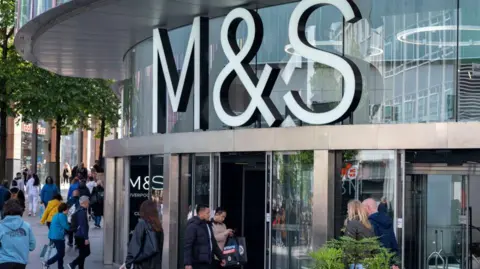The venerable British retailer, Marks & Spencer (M&S), currently grapples with an extensive cyber disruption, marking a challenging period for one of the UK’s most recognized brands. Reports indicate that the repercussions of this cyber incident have contributed to significant disturbances in store operations and have resulted in the complete suspension of its online ordering services.
The chaos surrounding M&S began during the Easter weekend when various customers started experiencing issues related to its Click & Collect service and contactless payment systems. The company officially acknowledged that it faced a “cyber incident.” Although M&S managed to restore some services, it ultimately decided to halt online orders across its website and mobile applications last Friday. Nearly a week later, there remains an air of uncertainty surrounding the timeline for resuming its online operations. This prolonged suspension has left many customers frustrated, especially as some physical stores are reportedly lacking essential food items due to the current state of affairs. The company has placed visible signs in its stores, requesting patience from shoppers as they navigate these technical difficulties.
Upon closer examination, it was revealed that the attack on M&S’s systems was a ransomware incident. This form of malware is specifically engineered to block access to crucial data by encrypting it until a ransom is paid. The cyber criminal group associated with the attack is identified as “DragonForce,” which allows other cyber felons to utilize its malicious software. Security experts have indicated that a loosely connected network of youthful hackers, known as “Scattered Spider,” may be behind the actual infiltration into M&S’s systems.
The financial impact from this cyber breach is already severe, with estimates suggesting that the company is facing losses amounting to millions of pounds. The immediate consequences saw M&S’s share price plummet by 6.5%, translating to a staggering loss of more than £500 million in market value. A significant portion of the retailer’s revenue comes from its online sales, particularly in clothing and home goods, which account for approximately 33% of its overall sales. On average, M&S typically accumulates about £3.8 million daily from online transactions, emphasizing the grave impact of the ongoing disruption.
The unfortunate timing of the attack is particularly ill-fated as it coincides with warmer weather in the UK, traditionally a peak shopping season for summer apparel. Analysts speculate that many M&S customers may turn to competitors rather than visit brick-and-mortar locations, thus amplifying the retailer’s challenges during this critical selling period.
Moreover, suppliers dependent on M&S have expressed concern as they maintain close contact with the retailer to monitor the situation, indicating that they have not yet faced significant disruptions. However, executives like Thea Green from Nails Inc have conveyed anxiety regarding imminent launches associated with M&S during this tumultuous period, noting that while the effects are not catastrophic for their businesses, M&S remains an important customer.
While communication from M&S concerning the cyber attack has been somewhat sporadic, the company has released statements addressing the incident. However, experts have cautioned that prolonged silence might harm consumer trust, especially amidst growing concerns about transparency and accountability in the digital landscape. There’s an evident need for M&S to communicate clearly with its customers and stakeholders to mitigate any associated reputational damage.
As this situation continues to evolve, M&S’s ability to recover from this cybersecurity crisis will not only depend on crisis management but also on its capacity to reassure customers of its operational integrity moving forward. Given the turbulent landscape of modern retail, effective communication strategies will be pivotal for M&S in regaining consumer confidence and navigating through this unprecedented challenge.



